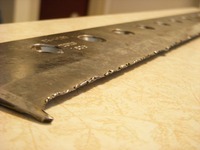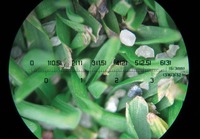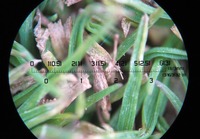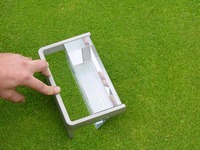In terms of cylinder mower maintenance, the bottom blade often gets overlooked. Bottom blades take a lot of abuse in the cutting process – they have cylinders blades smacking against them at a high velocity, they run over sand and turf, hit debris, and are dragged across various surfaces.
However, spending a little more time and attention on your bottom blades could reap serious benefits for your facility in terms of quality of cut and replacement parts.
Regular bottom blade inspection is crucial to having consistent, predictable performance from your mowers. If your bottom blades aren’t ‘spot on’, could you expect your turf surface to exhibit any sort of consistency?
One of the most important things you can do to keep your bottom blades in good shape is to keep them surgically sharp and maintained with the correct manufacturer’s front and top-face angles.
 The front face angle – grass doesn’t always grow perfectly straight up. It grows ‘up’ but, generally, in several different directions. As a mower moves across turf, the front face angle of a bottom blade pushes grass blade tips straight up to be cut by the revolving cylinder blade.
The front face angle – grass doesn’t always grow perfectly straight up. It grows ‘up’ but, generally, in several different directions. As a mower moves across turf, the front face angle of a bottom blade pushes grass blade tips straight up to be cut by the revolving cylinder blade.
At this point, with a sharp cylinder blade, grass blade tips that have been presented by the front face angle of the bottom blade will be scythed off.
This correct angle on the front face is always negative (generally around -5 to -7 degrees for greens mowers).
If the angle is wrong (i.e. a positive or neutral angle), as the mower moves along the grass, the front face can actually push the grass blade tips over (or lay them down) away from the revolving cylinder blade so they won’t be cut.
This is commonly referred to as ‘ragging’, as the turf surface can look ragged from inconsistent cutting. Another common occurrence from the wrong angle being ground on the bottom blade is the appearance of a ‘beard’ of grass blade tips hanging off the front face. Grass blade tips fold over the front face and it looks as if the bottom blade has a beard. Many of you might have seen this before?


The top face angle – The top face angle of a bottom blade ensures that once grass blade tips have been cut they are properly ejected away from the cutting point. This angle must be negative as well.
If the angle on the top face is not correct (i.e. positive or neutral angle) grass blade tips will not be properly ejected from the cutting point and clippings will begin to collect on the cylinder. Eventually the cylinder will get clogged up with excess clippings.
Tools of the trade
To ensure your bottom blades are in good working order, it is always good to keep a facing tool handy like Bernhard’s Rapid Facer. A quick and easy facing tool will allow turf managers to apply a touch-up grind to the front face of bottom blades, keeping them in good working order.
In addition, the company also supplies two new tools to take an ‘up close’ and in-depth look at your grass blade tips.

A macroscope allows you to examine turf in detail. This tool gives you an in-depth look to see exactly what is happening to your grass blade tips after cutting. Are they bruised and ragged, or turgid and green? The macroscope allows you to see for yourself.
A prism gauge shows you how your cutting units are performing. Are they all operating at the same height of cut and leaving smooth, clean edges?
The prism gauge allows turf managers to view the cut and condition of their turf after being mown. You can see the blade tips and determine the height of cut. There is an easy to view ruler and magnification glass, which makes this the easiest tool to see what is really happening with your turf.
It might be surprising, but you can drastically improve the quality of cut you achieve at your facility every day, just by paying a little more attention to your bottom blades.
Again, back to the basics – a good cut means healthier turfgrass, smoother surfaces and better working cutting equipment. As turf managers attempt to establish ideal turf standards at their facilities, they will try lower heights of cut, rolling, low fertility and low irrigation, but I’m convinced many would be amazed at the instant impact of a well-adjusted, sharp bottom blade.
